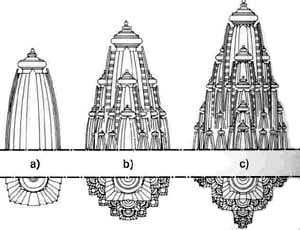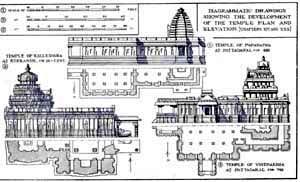Nov 06, 2025
Nov 06, 2025
 The principal architectural features of a temple are as follows:
The principal architectural features of a temple are as follows:  A detailed analysis of temple architecture reveals that much of its character was the result of repetition of motifs. Thus looking at the Shikhara we see that it is made up of many miniature ones repeating themselves time and again. In fact these repeating motifs in themselves were miniature shrines. Two main types of motifs/mini shrines exist, depending on the geographical location of the temple. These two types make up the Indian temple 'orders', and are called the Dravida, found mostly in the south, and the Indo-Aryan, in the north.
A detailed analysis of temple architecture reveals that much of its character was the result of repetition of motifs. Thus looking at the Shikhara we see that it is made up of many miniature ones repeating themselves time and again. In fact these repeating motifs in themselves were miniature shrines. Two main types of motifs/mini shrines exist, depending on the geographical location of the temple. These two types make up the Indian temple 'orders', and are called the Dravida, found mostly in the south, and the Indo-Aryan, in the north.  It is fairly clear that some of the architectural character of the temple was a direct influence from Buddhist architecture. For example, the introduction of the chaitya arch (kudu), and the unmistakable vaulted roof as survives in the Teli-ka-Mandir at Gwalior.
It is fairly clear that some of the architectural character of the temple was a direct influence from Buddhist architecture. For example, the introduction of the chaitya arch (kudu), and the unmistakable vaulted roof as survives in the Teli-ka-Mandir at Gwalior.
15-Feb-2001
More by : Ashish Nangia

|
I know. |

|
GOOD. INFORMATIVE |